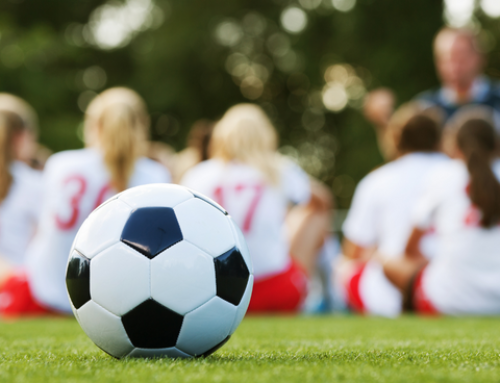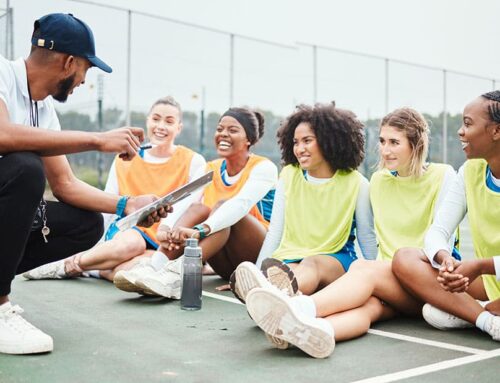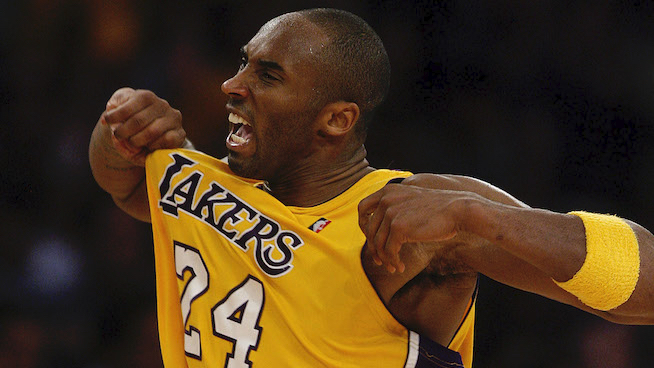![]()
It’s easy to get stuck in a rut with group training, leaving you completely overwhelmed. It wasn’t until I had to hire employees due to a rapid rate of business growth that I really began to appreciate specific parameters to help my coaches and athletes and make their life easier.
When I first started training groups, there were times when I felt completely frustrated and overwhelmed because the outcome wasn’t exactly what I wanted or knew it could be. There’s no worse feeling in business than having clients not fully satisfied with their training experience. Often, clients don’t know how good a service is until they experience it, so even though I was unhappy with what was occurring, clients were still happy with the results and my retention rate was high.
RELATED: Improve Your Athletes’ Health and Mental Focus With Team Yoga Practice
As a professional, though, you have to know the difference. But over the years and thousands of hours spent training, I learned to master the principles I’m about to share with you, so that I knew I was providing the best service I could and leaving an even better lasting impression in the process.
1. Urgency

This training element is huge when you consider that you will be training athletes in succession for potentially several hours. Any delay or setback in the training session can create a backup and decrease the quality of the workout. I preach to my training staff that they always need to try and stay ahead no matter the situation, or how things are going. Not only is this beneficial from a physiological standpoint, resulting in improved hormonal profiles, but it keeps things humming along and reduces stress for all parties involved.
2. Space Management
Although having too little space can be an issue at times, when working with groups, I feel it’s far less stressful if the coach or trainer can confine the group to tight quarters—not to the extent where the clients feel a lack of privacy, but just enough to manage everyone without losing sight of individual clients, which can happen if they are dispersed all over the place. Feedback from my staff has been positive about this guideline, and it definitely makes the training situation easier in my experience. Moreover, if you are tending to one client and losing sight of another due to their occupying too much available training space, you will almost guarantee technical training errors, which will inevitably compromise health and performance at some point.
RELATED: Get Fit With This Brutal Military-Inspired Workout
3. Coaching Angles

This is another common issue, which I observe in young coaches on a regular basis. Ideally, it’s most appropriate to use an oblique or diagonal vantage point relative to the training position of your athletes. And if you are managing space properly, this shouldn’t be a problem, because there are different specific techniques that you have to account for with your athletes from both a linear and lateral perspective, which affects performance in the exercise being performed at that moment. Another secondary approach is exploring the space and covering all potential angles outside the group. Coaches often select the wrong angle, but they also get comfortable and lazy and just end up standing around in one location, thus missing out what is occurring elsewhere. Another benefit from this coaching strategy is better focus and attention. Moving around improves your mental acuity and engagement; and from a spectator viewpoint, you look more professional and personally involved since you are constantly monitoring and observing technique from all angles.
4. Verbal Cueing
Verbal cue ability becomes very significant in a group training scenario. Providing a demonstration for a particular athlete while others are performing a prescribed exercise diverts your attention away from the majority, which is obviously a recipe for disaster. Having specific cues or teaching systems for each and every exercise in your program is mandated and only fair to the athletes who are paying you for a high level service. It requires more critical thinking and planning at the onset, but after awhile you can identify cues that work with everyone, and the process becomes automatic. It also helps to work with several athletes in a one-on-one setting at first, trying out different suggestions for movements, taking notes and success rates, and then re-evaluating the productiveness of those specific cues after hours.
RELATED: 4 Strategies to Create a Successful Weight Room Environment
5. Preparation

I hate to sound like a broken record, but your performance as a coach and trainer is limited by your level of preparation. Data collection, program design (exercise, sets, reps, rest, etc.) and customization should be provided for every client before the training session commences. The logistics of your facility design and layout need to be calculated and every situation accounted for, so when the time comes, there is no confusion or finger-pointing. As a coach, you have to be accountable and anticipate almost everything that could happen. Again, this approach involves more effort initially, but it will save you a lot of work later on and make everyone happy.
6. Sequential Coaching
This topic ties in nicely with your verbal cue skills. If you are on point verbally and know exactly how to elicit the precise movement response that you want, being sequential with your coaching should follow naturally. In other words, the objective is to address whatever technique your client is deficient at in that moment, fix it, and then move on to your next client. This process repeats over the course of the entire training session. You have to be urgent, completely focused, assertive and confident.
This is “make or break” for me when I’m looking to hire or retain a trainer. How do they perform in an intense high-pressure environment? Do they fold or do they step up? You can give a trainer all of the tools necessary and spend hours training him to be a great coach, but eventually it comes down to his level of motivation and passion to want to be a coach and give all they have to the clients. Again, working one-on-one with your athletes and then increasing the number of athletes participating in a group will build familiarity with your training system and reduces headaches and workload.
[cf]skyword_tracking_tag[/cf]RECOMMENDED FOR YOU
MOST POPULAR
![]()
It’s easy to get stuck in a rut with group training, leaving you completely overwhelmed. It wasn’t until I had to hire employees due to a rapid rate of business growth that I really began to appreciate specific parameters to help my coaches and athletes and make their life easier.
When I first started training groups, there were times when I felt completely frustrated and overwhelmed because the outcome wasn’t exactly what I wanted or knew it could be. There’s no worse feeling in business than having clients not fully satisfied with their training experience. Often, clients don’t know how good a service is until they experience it, so even though I was unhappy with what was occurring, clients were still happy with the results and my retention rate was high.
RELATED: Improve Your Athletes’ Health and Mental Focus With Team Yoga Practice
As a professional, though, you have to know the difference. But over the years and thousands of hours spent training, I learned to master the principles I’m about to share with you, so that I knew I was providing the best service I could and leaving an even better lasting impression in the process.
1. Urgency

This training element is huge when you consider that you will be training athletes in succession for potentially several hours. Any delay or setback in the training session can create a backup and decrease the quality of the workout. I preach to my training staff that they always need to try and stay ahead no matter the situation, or how things are going. Not only is this beneficial from a physiological standpoint, resulting in improved hormonal profiles, but it keeps things humming along and reduces stress for all parties involved.
2. Space Management
Although having too little space can be an issue at times, when working with groups, I feel it’s far less stressful if the coach or trainer can confine the group to tight quarters—not to the extent where the clients feel a lack of privacy, but just enough to manage everyone without losing sight of individual clients, which can happen if they are dispersed all over the place. Feedback from my staff has been positive about this guideline, and it definitely makes the training situation easier in my experience. Moreover, if you are tending to one client and losing sight of another due to their occupying too much available training space, you will almost guarantee technical training errors, which will inevitably compromise health and performance at some point.
RELATED: Get Fit With This Brutal Military-Inspired Workout
3. Coaching Angles

This is another common issue, which I observe in young coaches on a regular basis. Ideally, it’s most appropriate to use an oblique or diagonal vantage point relative to the training position of your athletes. And if you are managing space properly, this shouldn’t be a problem, because there are different specific techniques that you have to account for with your athletes from both a linear and lateral perspective, which affects performance in the exercise being performed at that moment. Another secondary approach is exploring the space and covering all potential angles outside the group. Coaches often select the wrong angle, but they also get comfortable and lazy and just end up standing around in one location, thus missing out what is occurring elsewhere. Another benefit from this coaching strategy is better focus and attention. Moving around improves your mental acuity and engagement; and from a spectator viewpoint, you look more professional and personally involved since you are constantly monitoring and observing technique from all angles.
4. Verbal Cueing
Verbal cue ability becomes very significant in a group training scenario. Providing a demonstration for a particular athlete while others are performing a prescribed exercise diverts your attention away from the majority, which is obviously a recipe for disaster. Having specific cues or teaching systems for each and every exercise in your program is mandated and only fair to the athletes who are paying you for a high level service. It requires more critical thinking and planning at the onset, but after awhile you can identify cues that work with everyone, and the process becomes automatic. It also helps to work with several athletes in a one-on-one setting at first, trying out different suggestions for movements, taking notes and success rates, and then re-evaluating the productiveness of those specific cues after hours.
RELATED: 4 Strategies to Create a Successful Weight Room Environment
5. Preparation

I hate to sound like a broken record, but your performance as a coach and trainer is limited by your level of preparation. Data collection, program design (exercise, sets, reps, rest, etc.) and customization should be provided for every client before the training session commences. The logistics of your facility design and layout need to be calculated and every situation accounted for, so when the time comes, there is no confusion or finger-pointing. As a coach, you have to be accountable and anticipate almost everything that could happen. Again, this approach involves more effort initially, but it will save you a lot of work later on and make everyone happy.
6. Sequential Coaching
This topic ties in nicely with your verbal cue skills. If you are on point verbally and know exactly how to elicit the precise movement response that you want, being sequential with your coaching should follow naturally. In other words, the objective is to address whatever technique your client is deficient at in that moment, fix it, and then move on to your next client. This process repeats over the course of the entire training session. You have to be urgent, completely focused, assertive and confident.
This is “make or break” for me when I’m looking to hire or retain a trainer. How do they perform in an intense high-pressure environment? Do they fold or do they step up? You can give a trainer all of the tools necessary and spend hours training him to be a great coach, but eventually it comes down to his level of motivation and passion to want to be a coach and give all they have to the clients. Again, working one-on-one with your athletes and then increasing the number of athletes participating in a group will build familiarity with your training system and reduces headaches and workload.
[cf]skyword_tracking_tag[/cf]













